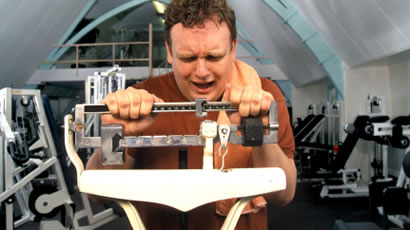 Has your current routine stopped yielding results? This is very common in fitness and bodybuilding. Many times we are so wrapped up in follow a specific plan or weight loss routine that we do not stop and think about challenging our bodies in new ways. Actually, if you do not continually update and mix in new exercises everyone will hit a plateau at some point.
Has your current routine stopped yielding results? This is very common in fitness and bodybuilding. Many times we are so wrapped up in follow a specific plan or weight loss routine that we do not stop and think about challenging our bodies in new ways. Actually, if you do not continually update and mix in new exercises everyone will hit a plateau at some point.
A plateau is when you stop seeing results, the scale will not budge, and you start to lose hope, but this does not have to be the case. With some simple changes in diet and exercises you will back on track in no time.
What happens is that our bodies become more efficient as we repeat exercises. More efficient is a good thing because that means your body is adapting to working out harder. However, you will start to burn fewer calories per exercise and you overall daily calorie burn will be lower.
Change Up Your Diet
 One of the first things you can do when trying to break a plateau is to switch up the things you eat and the frequency you eat meals. To keep your metabolism burning you need to constantly feed it small meals, this way it is never too full and will not slow down.
One of the first things you can do when trying to break a plateau is to switch up the things you eat and the frequency you eat meals. To keep your metabolism burning you need to constantly feed it small meals, this way it is never too full and will not slow down.
Breakfast is essential! Your metabolism has slowed throughout the night because it has no food intake. Yes, if you do not eat for long periods of time your metabolism actually slows down and will stop losing weight. Also, if your body does not receive enough nutrients, it becomes less efficient and starts storing extra fat to burn when it goes through another long period of food deprivation. So start the day off right with breakfast.
Some people are more sensitive to carbohydrate intake. Try switching some of your carbs to a protein source and this can often help break the plateau. Another trick is after an intense workout — get some form or protein in your body within 30 minutes of exercise. This will help the muscles you just worked repair and keep your metabolism fired for hours.
Another way to keep your metabolism revved up is by eating five to six small meals a day. The key is balance. Choose healthy foods like lean proteins, vegetables, and fruits. Replace sugary foods with foods that are non-processed and high in fiber, an apple or Larabars are great replacements, and most importantly, drink lots of water.
Sometimes we confuse hunger and thirst. Try drinking a glass of water the next time you think you are hungry, you will be surprised by how fast your hunger goes away.
Switching Up Your Workout Routine
The next factor to beating your workout plateau is to switch your routine every 3 to 4 weeks. The body needs to be constantly guessing and adapting so that you can continually see results. You need to sit and think about what your goal is. Are you trying to lose weight, build muscle mass, or increase your endurance? Whatever your goal might be, you need to have a plan that keeps your body guessing.
Make a list of exercises that work the muscle or muscles you are planning to train. Then make up a couple of different workouts from that list. Use one workout for a couple weeks and then switch to the next workout. Make sure you are increasing your weight, as your body gets stronger. A common reason for a plateau is that people get comfortable with a weight they are using and don’t push themselves to move up to the next level.
Variety is another key component. The National Strength and Conditioning Association (NSCA) states that, “variety in your exercise routine will continue to stimulate your muscles or cardiovascular system, preventing you from over-training or reaching an unwanted plateau.” This can be done by adding intervals into your runs, plyometric exercises to your weight training program, or by trying spin, football, or basketball. These tips can help you use a variety of different energy sources so your body is constantly guessing.
Try Applying the Overload Principle
 The NSCA defines the overload principle as, “in order to keep making gains from an exercise program, you must find some way to make it more difficult.” Your body becomes more efficient and adapts to an exercise the more you repeat it. So to do this there are some there are some changes that can be made to keep this from happening.
The NSCA defines the overload principle as, “in order to keep making gains from an exercise program, you must find some way to make it more difficult.” Your body becomes more efficient and adapts to an exercise the more you repeat it. So to do this there are some there are some changes that can be made to keep this from happening.
First, try increasing the volume of work. This means increasing the number of sets, repetitions, or a combination of both. It will make your body have to adapt again, which means increasing calories burned or muscle mass. This is great for challenging larger muscles like the quads and latissimus dorsi.
Next, try changing the exercises and switch up the order in which you do them. If you normally work back and triceps one day, then try adding legs into the mix. Your body will not be ready for this and will be forced to adapt. There are so many exercises out there that train the same muscles but use different movements.
Also, when you switch the order of the exercises that will challenge your muscles in new ways. Muscles that were fatigued before will now be fresh and able to lift more weight. This change will also give you new variety. In the end you will become stronger and keep your workouts interesting.
Beating Your Workout Plateau
Whenever we first start a workout routine, the results tend to come fast, but our bodies are made to adapt and become more efficient. So in order to keep a plateau from happening, we need to constantly keep our muscles and cardiovascular system guessing. Focus on switching up your strength training routine ever three to four weeks.
Make sure you are not under eating or going too long without eating, which can trigger fat storage. The University of Colorado had a study that found that some metabolisms just need a workout of their own by increasing the total amount of calories your eat over five to six small meals a day. Your metabolism will constantly be working which will lead to a total, overall calorie burn.
If you mix and balance, working out harder, variety in exercises, and eating right you will keep your body from hitting a plateau. Find a balance that works for you and incorporate into your workout plan and get ready to see maximum results for a long time!